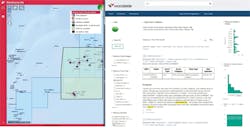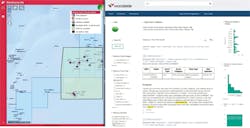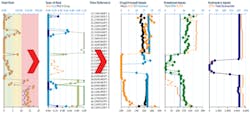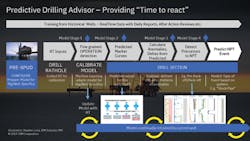Artificial intelligence improves real-time drilling data analysis
Ole Evensen, Øystein Haaland, IBM
Well deliverymay be the mother of all exploration processes. Since Colonel Drake’s first commercial oil well in Pennsylvania 150 years ago, drilling has been one of the most critical and costly exploration and production activities. Today, artificial intelligence (AI) is making a difference in a discipline looking for major improvement.
During the last decades there have been major changes in well requirements and drilling capabilities. Increased depth, directional drilling, extended lengths and higher pressure and temperature are some aspects changing the game. While new capabilities allow us to realize more ambitious well objectives, we also face new challenges. More sophisticated rigs, control systems and operating models call for better collaboration with more, timely and shared insight during operations.
An exploration well is a major capital investment with financial, operational, and reputational risks. According to Rystad Energy’s Global Well Report – Q3 2018, more than 73,000 wells are expected to be drilled and completed during 2019. While most of the wells are onshore, more than 2,400 are offshore wells - all increasing in complexity and length. While Colonel Drake’s first well was about 21 m (69 ft), the average length across all well types will be about 3,200 m (10,499 ft) in 2019.
The AI training of the system allows Woodside users to leverage everything reported in offset wells for immediate, accurate, and comprehensive insight with the purpose of identifying geohazards. (All images courtesy IBM)
All the above is contributing to the complexity and consequences of the continuous decision-making, from “request to drill” until the well is completed. Each decision will influence the well outcome, risk, time, and cost. The increasing volumes of data available from historical wells as well as from more “sensorized” drilling equipment allows for new insight but necessitates new decision support technology. AI will be pivotal in leveraging both historical and new Big Data for improved decision-making.
Types of AI-supported analytics
AI is a term used to cover different types of analytics. Two relevant types relevant for well delivery are natural language understanding (NLU) and machine learning (ML). The first type may be more intuitive as AI is used to read documents, written by people for other people to read – as if the AI system was an expert. A good well delivery example is Woodside’s “Watson for Drilling,” initially referred to as Geohazard Advisor.
Using NLU to read data from completed wells, the well delivery team can select an area of interest on a GIS map interface, and immediately get all relevant information from wells within their target area.
Throughout the planning phase much of the critical data is “unstructured” – such as end-of-well reports, completion reports, and semi-structured daily drilling reports. The NLU aspires to extract the information within the text, as a domain expert would do. The Woodside solution understands key concepts described in reports without requiring specific keywords to be present. For example, a reference to a sudden influx of fluids and an action to increase the gravity of mud is “inferred” to describe the occurrence of a kick. The AI training of the system allows Woodside users to leverage everything reported in offset wells for immediate, accurate, and comprehensive insight with the purpose of identifying geohazards relevant for their project. The benefit is risk management, improved quality and efficiency. A Woodside executive said: “We used to spend 80% of our time looking for data and only 20% using it.” New technology allows domain experts to train the system, and users to give feedback, as opposed to previous programmatic approaches.
A different AI concept of machine learning becomes more interesting during a drilling operation, where the continuously streaming data is structured, from drill rig to downhole sensors and logging. Machine learning allows for new ways to learn from this data, as a recent example from Maersk Oil (now Total) will illustrate.
When a possible data pattern link emerged – like a “fingerprint” ahead of a non-desired situation, it would be tested on other data sets for verification.
AI applied to real-time predictive drilling analytics
The (Maersk Oil) Total team explained their challenge as “significant NPT events and performance variability” which experience alone would not be enough to remedy. The well delivery team worked closely with an IBM industry team, led by Deb Chakraborty and supported by data scientists, geophysics and geologists with well delivery project experience. The project ambition was to explore how AI could provide improved warning time to critical situations by analyzing real-time data coming from the drilling operation, leveraging good practices from predictive initiatives in other industries.
The analytics approach was to start exploring data from previously completed well projects. Some had been delivered without incidents while others had experienced NPT (nonproductive time) problems such as stuck pipe with significant delay and additional cost.
Data scientists used AI algorithms in the IBM SPSS Statistics and Watson Studio to analyze data selected by the industry experts. The key data was all recorded channels, from wellbore to drill rig, ahead of observed events, such as a stuck pipe. The objective was to identify changes in data that could indicate that a “precursor” (e.g.: pack-off) to an event was developing.
The teams consulted the clients drilling engineers to understand if any “patterns detected” in the data could be linked to observations recorded by the drilling team during the time leading up to an incident. When a possible data pattern link emerged – like a “fingerprint” ahead of a non-desired situation, it would be tested on other data sets for verification.
This “supervised learning” approach is ideal when there is limited data sets for training. The amount of data from each well may be considered large, but there is usually not many delivered well projects with complete and quality data available for a more brute-force (unsupervised) analysis. Several data science approaches, applying different algorithms on direct or “derived” variables, were pursued to detect possible weak-signals of significance.
“Providing time to react” outlines how previous challenges of deploying AI models in new regions has been overcome by template supported preparation and rapid stepwise calibration.
The proof of the concept was judged by the models’ ability to successfully detect precursors and events within “blind-data sets,” which are completed wells not made available during training. The proof was declared positive when Joy Oyovwevotu, the Total Lead Drilling Engineer, said: “The predictions gives the operating team sufficient warning time to take actions to avoid events.” The AI approach also complemented physics models in ways not anticipated. As IBM’s industry expert, Stephen Lord, said after the successful well delivery pilot had been completed, “They expected to see early notification of known events, but they were equally impressed to see how close they had been to potential high-impact events which nobody had been aware of…”
AI complementing traditional first principle models
Today first principle models, building on established science of physics, are widely used to predict critical events in the active drilling phase, and they should continue to be so. Their strength is their ability to execute as anticipated “anywhere” – as rules of physics are universal. Their challenge has been to detect the weak signals that may not be obvious when analyzing only specific “physical relationships” in data. This is the opportunity space for AI to complement.
Applying AI without any bias to data sources and relationships, in a data-driven modeling approach, has enabled significantly increased precision and lead-time of predictions. However, AI has historically had a challenge with deploying models outside areas where they were “trained.” While AI models may be 80% “ready to move,” some adaptation is required to ensure a satisfactory level of precision and recall for events it is scouting for. A new drill site will introduce different formation and geomechanics. Additionally, new well plans and rig parameters must be tuned into the AI model. Finally, as drilling commences, new streaming data and observations will allow for final calibration of the model.
The data-driven approach is also capable of identifying new “signatures” or “fingerprints” as it builds an understanding of what constitutes normal behavior. When a new signature is identified, the subject matter expects can “relate” the findings to available data, replaying data and looking at drilling reports for observations of the event taking place. This approach of “supervised learning” extends the hybrid model capabilities and improves the prediction levels.
The next frontiers
Today we are working with “Narrow AI,” meaning that the focus is on vertical capabilities. In the well delivery world, we may consider the next step toward “Broader AI” will be to include more disciplines and combine more available data from new higher-fidelity sensors and unexplored sources. It may include seismic, logs, rock properties – and more unstructured data sources, such as documents used in the Woodside example.
AI will continue to complement existing first principle analytics models but will also bring the promise to help extract knowledge from previous projects. Advising your “next best action” will require natural (drilling domain) language understanding to help organizations improve processes and leverage knowledge for a competitive advantage.
We can also envision the opportunity to fuel digital twin models with real-time integrity data and deep analytical models to better assess the overall status of the drill rig, and systems. Examples may be corrosion, mooring and anchoring issues, and weather. Our next big goal should be to use all this structured and un-structured data to embed AI and deep learning analysis into the end to end well delivery processes. A digital twin vision could go beyond the physical facilities, to include the digital reservoir and even overburden.
Pursuing such opportunities will require an open “systems architecture” to support a services-oriented model. Competitive advantages will not come from your access to technology, but your ability to use it, and integrate data and services from involved partners. Looking beyond AI, technology such as Blockchain is enabling new ways of working. Blockchain is already explored as an enabling technology to develop new well delivery collaboration models that protects participants different business models, data and competitive differentiators. The technology allows data to be collectively used while individually protected and owned in accordance with “smart contracts.” This will not only help the industry to improve processes but also may allow for new service providers, offering orchestration and data facilitation. Adding value to well delivery by not being competitively engaged may sound strange, but “neutrality” is a competitive advantage for facilitators, just as being “open” should be a given requirement for all technology applied. •
The authors
Ole Evensen, Global Upstream Strategy Leader within IBM Chemicals & Petroleum, has served the oil and gas industry for more than 25 years. As Consulting Partner, he facilitated E&P process improvement and provided strategic advice for developing new organizational capabilities. He is currently helping operators to explore and introduce new AI technology to address business challenges and opportunities.
Øystein Haaland is CTO and Distinguished Engineer within IBM Chemicals & Petroleum. He has served the oil and gas industry for more than 25 years, developing new industry solutions in collaboration with R&D and international operators. Haaland is participating in industry standardization initiatives and developing technology accelerators to enable digital transformation.



